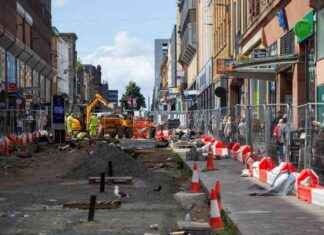Glasgow and Sydney’s Subway Challenges: A Comparative Analysis
Outsiders are running out of superlatives for Glasgow’s new Subway trains. For weeks, wide-eyed visitors have been raving about the bespoke cars built for what is one of the world’s oldest underground transit systems. Travel vloggers, in particular, cannot get enough of the visually striking Swiss-made replacements for the Metro-Cammel carriages of the very 1980s Clockwork Orange.
The buzz surrounding Glasgow’s new subway trains has reached international levels, with YouTubers JJ Extra and Edificity expressing awe at the futuristic design of the vehicles. The sleek white car bodies and orange accents have captured the imagination of viewers, drawing comparisons to aliens emerging from tunnels. This excitement is reminiscent of the hype surrounding Sydney’s newest Metro line, which has also been praised for its innovative and modern features.
Sydney’s subway system is undergoing a massive expansion, with a price tag of 65 billion Australian dollars. The new extension includes state-of-the-art stations and driverless trains, mirroring the advancements seen in Glasgow’s subway modernization project. Both cities are facing challenges with delays and budget overruns, highlighting the complexities of large-scale transportation infrastructure projects.
Despite the setbacks, the enthusiasm for these high-tech developments remains strong among commuters and transport enthusiasts. The allure of futuristic design and cutting-edge technology has captured the public’s imagination, sparking excitement and anticipation for the future of public transportation in both Glasgow and Sydney. As these cities continue to push the boundaries of innovation, it is clear that the evolution of subway systems is a global phenomenon that transcends borders and cultures.
Glasgow’s Subway Transformation
Glasgow’s subway modernization program has been met with both praise and criticism, as the new trains have faced technical issues and service disruptions. The futuristic design of the vehicles has garnered attention from around the world, with visitors and vloggers alike marveling at the sleek and contemporary aesthetic. However, the transition to the new fleet has not been without its challenges, as passengers have experienced delays and breakdowns that have led to frustration and inconvenience.
The Glasgow Subway, affectionately known as the “Clockwork Orange,” has a rich history dating back to the late 19th century. The recent overhaul of the system represents a significant investment in the city’s public transportation infrastructure, with the aim of improving efficiency and reliability for commuters. While the initial rollout of the new trains has been met with teething problems, officials are working diligently to address issues and ensure a smooth transition for passengers.
SPT, the organization responsible for the Glasgow Subway, has acknowledged the challenges faced during the modernization process. In a recent report, officials highlighted the successes of the new fleet introduction while acknowledging the service disruptions that have impacted customers. Despite the setbacks, the overall goal of enhancing the subway system remains a top priority, as Glasgow continues to position itself as a modern and forward-thinking city.
Sydney’s Subway Expansion
In contrast to Glasgow’s subway transformation, Sydney’s subway expansion represents a monumental undertaking that has reshaped the city’s public transportation network. The ambitious project, which includes the construction of shiny new stations and driverless trains, has been met with both excitement and skepticism. The cost of the expansion has raised eyebrows, with the taxpayer footing a hefty bill for the modernization of the subway system.
Sydney’s subway extension has faced its fair share of challenges, including technical and budget risks that have delayed the completion of the project. Despite these obstacles, officials remain optimistic about the future of the subway network, with plans for additional lines and services in the works. The recent launch of the latest extension drew praise from commuters and transport experts, who lauded the improved efficiency and convenience of the new service.
The parallels between Glasgow and Sydney’s subway challenges highlight the universal complexities of implementing large-scale transportation projects. From budget overruns to technical glitches, both cities are navigating the intricate process of modernizing their subway systems to meet the demands of a growing population. As the world continues to urbanize and expand, the need for efficient and sustainable public transportation solutions will only continue to grow.
The Future of Subway Systems
As Glasgow and Sydney strive to overcome the obstacles facing their respective subway systems, the future of public transportation is evolving rapidly. The shift towards driverless trains and advanced technology reflects a global trend towards innovation and efficiency in urban transit. While challenges remain, the determination of city officials and transport authorities to improve subway systems bodes well for the future of public transportation worldwide.
The public’s fascination with futuristic design and cutting-edge technology underscores the universal appeal of modern subway systems. From sleek white car bodies to state-of-the-art stations, the visual impact of these advancements is undeniable. As Glasgow and Sydney continue to push the boundaries of innovation, the world is watching with anticipation to see what the future holds for public transportation in urban centers around the globe.
In conclusion, the challenges facing Glasgow and Sydney’s subway systems are emblematic of the complexities of modernizing public transportation infrastructure. Despite setbacks and delays, the commitment to innovation and progress remains steadfast. As these cities forge ahead with their ambitious plans for subway expansion and modernization, the future of urban transit looks brighter than ever.
































